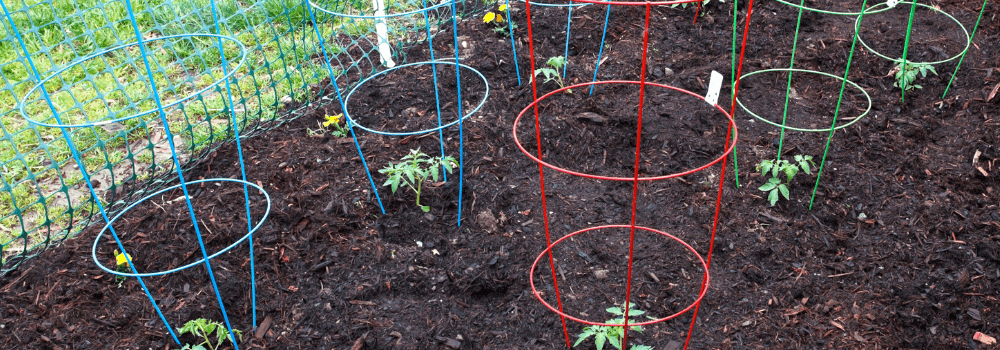
All About Plant Supports For Flower and Vegetable Gardens
Share
When it comes to gardening, one of the keys to healthy and beautiful plants is providing them with the support they need to thrive. Whether you're growing towering tomatoes, crawling cucumbers, or vivacious vines, selecting the right plant support can make all the difference. In this article, we'll delve into the world of plant supports, comparing the various types available to help you make the best choice for your garden. Let's get into the nitty-gritty of stakes, trellises, cages, and obelisks, and find out which support stars will help your garden grow to new heights.
Stake Your Claim
First up, let's talk about stakes. Simple, straightforward, and super effective, stakes are the go-to support for many gardeners. They're perfect for supporting individual plants like tomatoes, peppers, and young trees. Stakes come in a variety of materials, including bamboo, wood, and metal. Bamboo stakes are lightweight and eco-friendly, but may not be as durable as their metal and wooden counterparts. Wooden stakes offer a classic look and good durability, while metal stakes, often coated to resist rust, provide the strongest support for heavier plants. Using stakes is as easy as it gets: just push them into the ground and tie your plant to the stake as it grows. The key here is to ensure the stake is tall enough to support the plant at full height and sturdy enough to withstand wind and weather.
Linking Plant Supports
Metal linking plant supports are a versatile and innovative solution for gardeners looking to provide tailored support to their plants. These supports are particularly useful because they can be connected or "linked" together to create custom shapes and structures, catering to the unique needs of your garden's inhabitants. Metal linking plant supports can be used to encircle and support bushy plants or those with heavy blooms that tend to flop over or to provide temporary support to perennials in early spring, which can be removed or reconfigured as the plants grow and become more self-supporting. Used correctly they can Offer a discreet support system that focuses attention on the plants, not the supports, maintaining the natural beauty of your garden.
Trellis Talk
Moving on to trellises, these are the ultimate support system for climbing plants like cucumbers, peas, and certain types of flowers. Trellises come in various shapes, sizes, and materials, including wood, metal, and plastic. They not only provide support but also add a decorative touch to your garden. Installing a trellis allows your plants to grow vertically, saving space and improving air circulation around the plants. This can lead to healthier growth and easier harvesting. Wooden trellises offer a natural look but may require more maintenance, while metal and plastic trellises are more durable and weather-resistant.
Grid Supports: The Versatile Virtuoso
Grid supports, also known as plant support grids or grow-through grids, can support a wide array of perennials and annuals, from asters to zinnias. These supports consist of a grid held aloft by legs that stake into the ground. The beauty of grid supports lies in their versatility; they can be placed over plants early in the growing season, allowing plants to grow up through the grid and be supported as they mature. This method is especially beneficial for floppy, bushy plants that tend to splay outward as they grow. Made from metal or durable plastics, grid supports are discreet, blending seamlessly with the foliage while keeping your plants looking tidy and upright. They're a mix of function and stealth, keeping your garden looking natural and well-managed without visible scaffolding.
Cage Match
Tomato cages are another popular option for gardeners, especially those who are fans of the aforementioned fruit (yes, tomatoes are technically a fruit!). These cages are typically made of wire and offer a freestanding support system that encircles the plant. They're great for tomatoes, of course, but can also support peppers and eggplants. Cages help to keep plants upright and the fruit off the ground, reducing the risk of disease and pest problems. They're incredibly easy to use—just place them over the plant early in the season and let the plant grow into them. The downside? Some cages may not be tall or strong enough for indeterminate tomato varieties, which can grow quite large.
Obelisk Objectives
Lastly, let's not forget about garden obelisks. These tall, tower-like structures not only provide support for climbing plants but also serve as a striking garden feature. Obelisks are ideal for supporting roses, sweet peas, and ivy, offering them a framework to climb and flourish. Made from wood or metal, obelisks can vary greatly in design, from simple to elaborate. While they are more of an investment compared to other supports, their aesthetic appeal and functionality can transform the look of your garden.
Making the Right Choice
So, which plant support should you choose? The answer depends on the type of plants you're growing and the look you want to achieve in your garden. For individual, non-climbing plants or those that need a simple support, stakes are a practical and budget-friendly option. If you're cultivating climbers and want to save space or enhance the beauty of your garden, trellises and obelisks are your best bet. For tomatoes and similar plants, cages offer an easy and effective solution.
No matter what you choose, the right support will not only help your plants grow healthier and stronger but also add structure and style to your garden. So go ahead, stake your claim (or trellis, cage, or obelisk) and watch your garden reach new heights of beauty and productivity. Happy gardening!
